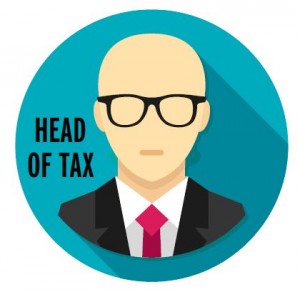Let’s tell it like it is. The role of the corporate tax practitioner has changed dramatically in the last twenty years as the tax function has expanded in scope and responsibility. Not surprisingly, the status of the head of corporate tax has changed as well, and now more chief tax officers are reporting directly to the chief financial officer (CFO). The participants convened to discuss the place of the chief tax officer in the corporate hierarchy. Joining in the roundtable were Janet Kreilein, senior director of tax and assistant treasurer at Fortis Management Group LLC; Don Rath, senior vice president of global tax and corporate risk assurance at Symantec Corporation*; and Cooper Monroe, director of state tax at Duke Energy Corporation.
Michael Levin-Epstein: When you first came aboard, what did the corporate structure look like in terms of the tax function?
Janet Kreilein: The senior tax leadership position has always reported to the CFO with one exception, and that was a unique situation where the controller was taking the lead on many CFO functions to allow the CFO to focus on M&A [mergers and acquisitions] work for a couple of years.
 Don Rath: When I joined the company, the head of tax position also reported directly to the CFO, and I don’t remember a time when that wasn’t the case.
Don Rath: When I joined the company, the head of tax position also reported directly to the CFO, and I don’t remember a time when that wasn’t the case.
Cooper Monroe: I’m going to go way back—to about 1988. At that time, the tax function reported to the controller, so it’s always been in the finance organization, but way back then the head of tax reported to the controller. Over time it’s migrated, as Janet and Don indicated, to report directly to the CFO. I think it’s an indication of an evolution of the tax department and recognition of the higher value provided by the tax function.
Levin-Epstein: In addition to recognizing the higher value that the tax function has, where did it originate that heads of tax started to report more to the CFO?
Monroe: I think it evolved out of the vice president of tax marketing to the rest of the organization the value that the tax department was providing to the enterprise. I also think the tax function across all industries has evolved and become more specialized. For instance, we became an international company, and that added complexity, which led to the recognition of the tax function as a field that needed to be represented directly to the CFO.
Kreilein: To follow up on that, in my organization, we were fairly active from a mergers and acquisitions perspective. And, often, to have the right tax results come from those transactions requires the tax team to be at the same table as the CFO as those transactions are being negotiated and modeled. So that approach has developed in our organization. When there is a business improvement activity or any activity that requires some modeling such as disposition or acquisition work, the tax team generally has a seat at the table. That lent itself well to reporting to the CFO position rather than the controller position. I would also add that some of reporting structures came about as a result of Sarbanes-Oxley—legislation that highlighted the tax functionality within organizations and put greater scrutiny on the tax function through subsequent audit requirements of an organization.
Monroe: I agree Janet—being at the CFO table allows for tighter integration across the different finance functions. Being under a controller limits that to an extent. I think it’s really about integrating tax into the multiple finance areas that can be touched, with M&A being one of those that you just pointed out.
Rath: I would agree with all of that, and I would also add that from what I’ve observed, there is a recognition by members of the board of directors that tax is growing in complexity. There is more risk than perhaps there has been in the past. They want the right person on the job, so I think there has been board pressure, or at least audit committee pressure, to upgrade the level of the lead tax role. In particular, this can happen after some sort of crisis. I’ve walked into situations in my career, for example, where there’s been a material weakness. The board wants to make sure it doesn’t happen again. Part of the solution is to make sure they have a senior-enough person in that role so that there’s better attention paid to the function and better integration to the rest of finance, and to an earlier point, that there’s a place at the table so that there is a direct line to the CFO.
Does Size Matter?
Levin-Epstein: How much of the reporting to the CFO is a function of the size of the company?
Monroe: I think there is a correlation between size and reporting level. Back in my early days, we were a much smaller company and, similar to Janet’s comments, we started being rather acquisitive and expanded the business. As Don pointed out, when that complexity increases, it’s more logical to report at the CFO level.
Kreilein: It depends to some degree on how smaller companies grow and develop perhaps from small organizations to organizations that perhaps have their own in-house tax department or from private to public companies. While they’re small, you are potentially dealing with the owners or founders of the organization, which lends itself to reporting at a higher level for the integration benefits that Don mentioned to make sure that the senior leadership understand the tax complexities of the operations. I see many small companies with tax leadership that report to the CFO. In my new role, it’s a smaller organization with a smaller department, and I currently report to the CFO, and I don’t see that changing.
Rath: I agree with that. I think in the past, from what I’ve observed with smaller companies, they tend to try to be lean. Part of the way they do this is they consolidate core finance into a couple of leadership roles—most often under the controller, sometimes under the treasurer—but then built into that structure is an assumption that the needs are primarily compliance-oriented and can be best integrated into other accounting or core finance functions. I think when a company reaches a certain size or scale, or it may perhaps be evolutionary either through a merger or through increasing international presence, it simply gets to a level of complexity where someone who doesn’t have a tax background finds that it’s too much to manage and often beyond their domain expertise. Those types of situations tend to lend themselves to relooking at the role. But I would also say that I’ve observed, over the last couple of years, that even smaller shops are hiring those lead tax jobs at executive level. I just think there’s an acknowledgement now that whether it’s small or large, the roles are hard, and you want to make sure you have right person in the role. And you typically need to upgrade from what you’ve historically hired in a comparably sized situation.
Do Titles Matter?
Levin-Epstein: What titles do the “heads of tax” have these days?
Monroe: At our organization, the lead tax person is the senior vice president of tax; we’re a big, publicly traded company. Others I’ve seen are chief tax officers, although that may not be as common. In our industry, it’s not uncommon to still have directors of tax be the head tax person.
Kreilein: I agree.
Rath: I don’t often see anything below “director.” Most commonly, the titles are at the director or senior director level at midsize companies and VP titles in larger organizations. I’m a Senior Vice President (SVP) because I have more than tax reporting into me. I was a VP when I joined, and I had only tax. I think very large companies often have an SVP-level person who runs only tax because, given the complexity of the organization, they need to hire at that level and with that breadth of experience to get the right person in the role.
Levin-Epstein: What are the top three functions of the head of tax?
Kreilein: I’ll throw some out. I’m not going to put these in any area of priority, but I would say one important function of the chief tax officer, whatever their title is, is risk management—understanding where risks are in the organization, making sure people understand those risks, are aware of those risks, manage around those risks, and hopefully mitigate those risks.
Another key function that I see is strategic planning. Strategic tax planning around acquisitions and dispositions can be critical to the success of that transaction, and that is a key role within any organization that has those kinds of activities within their finance department. A third one that I would suggest is management. It can be an overlooked functionality these days. I don’t think we as tax people get a lot of time to do management. Many of us do tax work every day. Management activities are something that we struggle to fit into the daily work of the department. But if you are in a senior leadership role, department management has to be a priority, and you have to find a way to make it fit into the day.
“In the tax department, major trade-offs revolve around tax technical capabilities—the need for deep specialization, which can make you a little less flexible—versus the greater breadth of a generalist who covers the full tax life cycle.” —Cooper Monroe
Monroe: I agree with all that, Janet, and broadly speaking, it’s about aligning the tax department with the overall business strategy, which is really what you just said on the front part of  your comment. Regarding management, I think one of the main management functions of the head of tax is developing people, having a strong bench, a good succession plan, really engaging employees. What really goes along with that is promoting the tax department within the organization, which the head of tax has a unique ability to do with the upper parts of management.
your comment. Regarding management, I think one of the main management functions of the head of tax is developing people, having a strong bench, a good succession plan, really engaging employees. What really goes along with that is promoting the tax department within the organization, which the head of tax has a unique ability to do with the upper parts of management.
Rath: I would definitely agree with those three areas with perhaps a little different color. I think tied to risk management is the overall responsibility for compliance, broadly speaking. I do think the senior management and the board attach a good deal of value to getting things right and how that influences perception of the organization and how that’s balanced with other financial risk.
A good part of the job is setting standards. It’s not a function of slowly pushing tax returns out the door. It’s about what is the appropriate standard of financial compliance for the company as whole, be that federal, state, international, income tax accounting. Where are you registered to do business? Where do you acknowledge taxable presence? All of that is hugely important and sometimes underestimated in terms of the level of effort required to make sure that the standard is understood and well communicated. I would attach to strategic planning kind of a broader function of business support. It’s not all about the sexier side of planning; it’s also kind of being at the table at the moment, whether it’s an important customer negotiation, whether it’s an M&A deal, or whether it’s getting the organization through a significant change. You’re kind of expected to be at the table in part with your tax hat on but also with your overall financial sense and to participate with the business in making informed decisions.
“One important function of the chief tax officer, whatever their title is, is risk management—understanding where risks are in the organization, making sure people understand those risks, are aware of those risks, manage around those risks, and hopefully mitigate those risks.” —Janet Kreilein
I think the third nuance that goes along with the broader management function is that you really are part of the CFO team. Part of what you do is obviously representing the interests and issues around tax, but you’re also expected to be in sync with your peers, aligned on key financial goals, and in a position to make trade-offs. So you may have to sacrifice the best tax result for an overall business or financial result, and I think that is an increasingly important part of the role and speaks to why the level of hiring and the nature of the role and how the position in the organization has changed. We’ve come a long way from being the geeks in the back room that no one understands what they do. Tax is very much more up front and visible and part of overall decision-making, and I think that requires a very different skill set than perhaps we’ve needed in the past.
Levin-Epstein: Are there any situations in which the head of tax reports directly to the CEO?
Kreilein: I’m not aware of an organization where the head of tax reports directly to the CEO.
Monroe: I’ve never seen that either.
Does CEO Access Matter?
Levin-Epstein: How about the access of the head of tax to the CEO?
Rath: I would say that, first of all, CEOs are very busy people. Not many people can kind of walk into the CEO’s office and have a chat at their discretion. I think the tendency is to perhaps filter many of those conversations through the CFO, who has more regular access, and I think just in the interests of protocol, that’s usually the route that’s chosen. Having said that, I do have some regular contact with our CEO. If I had a really important issue that I felt needed his involvement, I would have access. I’m very confident about that, and I could have that access without the CFO necessarily being in the room. But I also think there’s an expectation that you’ve been hired at the executive level—it’s kind of up to you, like any other area of the business, to run your function and to make decisions and to use judgment in terms of taking risks. So it really would have to be a fairly important issue to involve the CEO, simply because the expectation is that those situations would not require his or her involvement.
Kreilein: To follow up on one of Don’s other comments, when you’re dealing with strategic initiatives, whether they’re transaction-based or business-based, if the subject matter at hand is significant enough to be of interest and warrant the involvement of the CEO, they’ll likely be in the room at the table when the conversations are happening, so you do get direct access because they’re in there with their CFO planning whatever strategic process is being considered at the moment.
Levin-Epstein: In regard to the general corporate structure as it involves the tax function, is there any way that you would like to see it improved in an ideal organizational chart?
Monroe: You know, there really is no perfect organization design. It’s really about trade-offs, and it depends on the goals and investments you’re trying to make for your organization. In the tax department, major trade-offs revolve around tax technical capabilities—the need for deep specialization, which can make you a little less flexible—versus the greater breadth of a generalist who covers the full tax life cycle. Depending on what your goals are would dictate one approach or the other, also maybe controls as well. Knowing the business, being very connected to operations versus connected to the corporate headquarters function, will dictate how an organization might be designed: centralized versus decentralized, the connection to finance, whether you’re tightly integrated versus running parallel activities. All of those things I think are about trade-offs and aligning with the goals of organization as a whole.
Levin-Epstein: A junior associate has just been hired, and you ask that person, “What’s your goal?” They respond that they want to be head of tax. What advice do you give that person in terms of what they should be focusing on so one day they can be head of tax?
Rath: Sometimes I wonder why anyone would want this job. I guess the first thing I would say is “Really? Why do you really want this job?” It comes down to what’s your longer-term interest? Is it one where you want to be the best technical person? Is there a level of engagement with the organization that you truly enjoy? Or do you aspire to a role that has sort of the good and the bad? It’s great to be in a leadership position. It’s great to have the ability to make decisions. It’s great to get out of the weeds and have other people take care of those things But it’s also a tough job.
 I would say if that’s really where you want to land, then you should focus on a couple of things. First of all, you’ve got to be willing to get out of a space where you perhaps have your highest comfort level and gain a level of competence in a broad array of areas in tax. If you’re a federal expert, you’ve got to be willing to learn international and income tax accounting. You’ve got to be willing to learn the technical skill sets at least at a level that that allows you to make a contribution and enable the organization to make decisions. I’d say it’s also very important is to be prepared to make a lot of compromises and trade-offs along the way, and build that into your comfort zone. The more you get involved with the business, the more you realize that tax doesn’t drive everything. And it’s not all about getting the best tax answer; it’s about getting to the best after-tax decision for the company, and that’s a tough lesson for people to learn if they’ve grown up in a technically oriented space and have trained themselves to get to that best tax answer. The last area is that you have to have a vision around everything you do. It’s not about just getting the task done, it’s about what the process looks like and how can it be improved. Where does it integrate with other parts of the work of the department? And you need to carry that vision with you, because that’s how you need to develop that broader thinking that allows you to connect the dots and really go from a contributor to a leader and articulate those connections. I think the sooner you learn to do that in your career, the better. Otherwise, you’ve got to learn to do it the hard way later.
I would say if that’s really where you want to land, then you should focus on a couple of things. First of all, you’ve got to be willing to get out of a space where you perhaps have your highest comfort level and gain a level of competence in a broad array of areas in tax. If you’re a federal expert, you’ve got to be willing to learn international and income tax accounting. You’ve got to be willing to learn the technical skill sets at least at a level that that allows you to make a contribution and enable the organization to make decisions. I’d say it’s also very important is to be prepared to make a lot of compromises and trade-offs along the way, and build that into your comfort zone. The more you get involved with the business, the more you realize that tax doesn’t drive everything. And it’s not all about getting the best tax answer; it’s about getting to the best after-tax decision for the company, and that’s a tough lesson for people to learn if they’ve grown up in a technically oriented space and have trained themselves to get to that best tax answer. The last area is that you have to have a vision around everything you do. It’s not about just getting the task done, it’s about what the process looks like and how can it be improved. Where does it integrate with other parts of the work of the department? And you need to carry that vision with you, because that’s how you need to develop that broader thinking that allows you to connect the dots and really go from a contributor to a leader and articulate those connections. I think the sooner you learn to do that in your career, the better. Otherwise, you’ve got to learn to do it the hard way later.
Kreilein: I would expand on some of those concepts, in terms of Don’s comment about why some of us choose to do this. I would say for me, without question, the reward is always seeing the business grow, develop, and move forward and get better. It’s very exciting to be a part of developing a business model, whether that is a small company or a very large company. It’s really important if you want to be that cross-discipline contributor that you have some capacity for other finance skills. You have to have some understanding of what happens in the treasury function and the financial reporting function and in some of the other financial disciplines that come under that finance umbrella to be able to take your subject-matter expertise and integrate that expertise with what is doable or not doable within those other finance functions. That requires a sort of natural curiosity of what the rules are in other areas that have to be adhered to and considered in any strategic planning or improvement process.
“From what I’ve observed with smaller companies, they tend to try to be lean. Part of the way they do this is they consolidate core finance into a couple of leadership roles—most often under the controller, sometimes under the treasurer—but then built into that structure is an assumption that the needs are primarily compliance-oriented and can be best integrated into other accounting or core finance functions.”—Don Rath
Monroe: I would add a necessary skill for a head of tax is being a good steward of people. It takes some selflessness and some risk-taking, which doesn’t always come naturally. And really, if I was going to give some overall career advice, you have to personally take some risks in your career. As Don said, get outside your comfort zone and take jobs that are not comfortable for you. That’s the way you grow your career and develop. Finally, networking is a big skill possessed by heads of tax. It starts with a really good internal network both within finance and within the business, as well as external networking. I think an organization like TEI is the best place to begin that networking for a tax professional.
* Since this interview, Don Rath has become Vice President–Tax at Synopsys Inc.




